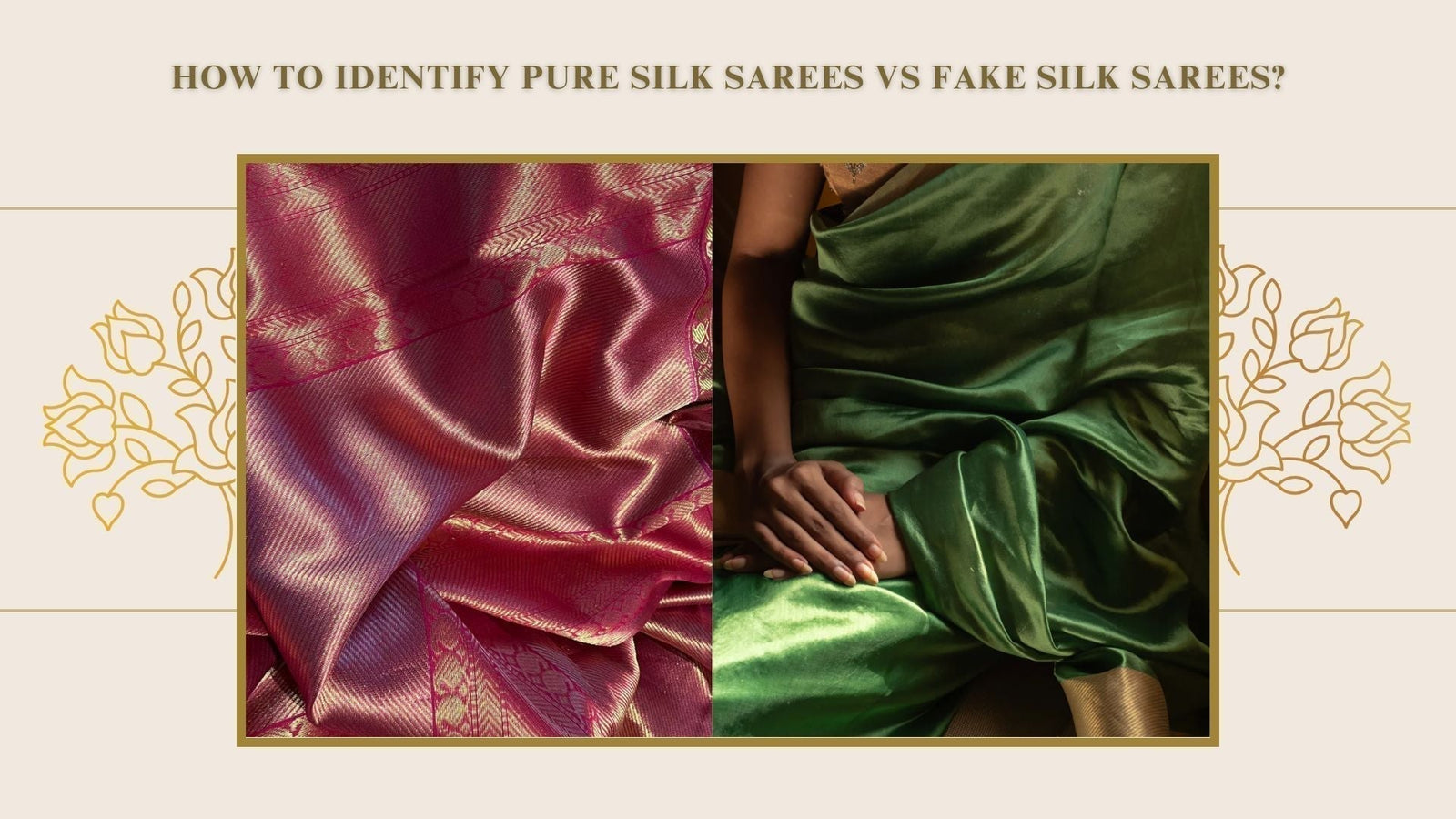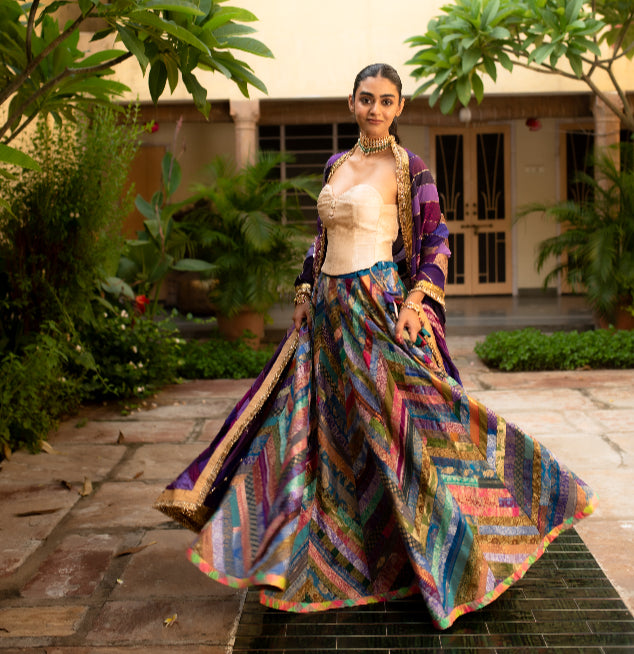Guide: How to Identify Pure Silk Sarees vs Fake Silk Sarees?

Introduction
The culturing process for a pure silk saree begins from the gossamer cocoon of Bombyx mori. The cocoon produces thin silk filaments—the finest filament could measure a kilometer or more in length. This is sericulture, wherein the silk farmers rear silkworms, harvest cocoons, and withdraw filaments. The threads are then degummed, the gum or sericin removed.
Now, only the silk thread remains, which is reeled, spun, and stretched to be made into thin strands. These strands are fixed on warping frames to create vertical warps. The cross threads (wefts) are introduced shuttle after shuttle, usually on a brocade or phenta (a traditional Indian handloom frame for intricate weaving) handloom. Through such a cumbersome manual process, each fabric has its idiosyncratic traits. Minor irregularities, delicate nuances, and a golden glow mark genuine handcrafted silk.
What Sets Priyanka Raajiv’s Pure Silk Sarees Apart?

Priyanka Raajiv stands apart as an authentic heritage, handmade, and sophisticated design aesthetic in our collection of pure silk sarees for women. Each saree is handwoven through traditional processes, which still revel in the gorgeousness of the traditionalness of artisan heritage yet allow for a no-expiry timeliness. We ensure to use only premium-grade silk, are diligent with design details that take great care, and are committed to slow fashion associated with the thinking that the aim is to create classic everlasting pieces that are anthropologically true to greatness regarding Indian craft.
Why It’s Important to Identify Pure Silk Sarees?

When you select a pure silk saree for women online, you can expect that it is breathable, comfortable, a representation of tradition and history, and a support for craft artisans. Fake silk is less durable, does not offer the same level of absorbency, and lacks identity, along with cultural and emotional significance. Being able to identify real silk will save you and the consumer both the money and heartbreak of identifying fake silk.
Key Differences Between Pure Silk Sarees and Fake Silk Sarees

Before any explanations, remember that fake silk can look like real silk, but pure silk is a feel thing, a finish thing, and a workmanship thing. Pure & luxurious silk sarees are usually woven by hand to a pattern that will have small manufacturing irregularities, indicative of a weaving establishment, and at the very least, human involvement. Fake silk products are usually mass-produced, often on enormous machine looms, with synthetic fibers, which may have a surface sheen but fall short on durability, comfort, and heritage. If you can tell the difference, you will be less likely to waste your money on something that is not quality, traditional, or genuine and offers a publicly selected lack of value for you.
1. Fiber Feel: About touch, silk has a soft feel, warmth, and a little resistance. Synthetic material is cold to the touch and plastic in feel.
2. Shine: Silk exhibits lustre as it reflects light at different angles. Synthetic fabric reflects light uniformly, without a glow.
3. Burn test: When lightly burning a small piece or thread, silk smells like burnt hair and leaves small, fine ash behind. Synthetic fibers have a burning plastic odor and tend to melt when exposed to heat.
4. Microscopic images: Silk fibers are irregular and generally appear in a ribbon shape. Honing in on a fiber under a microscope shows that synthetic materials have a smooth and even appearance.
5. Thermal comfort: Silk fibers naturally protect our bodies and contents at a stable temperature, while synthetic materials retain heat and cause discomfort in warm conditions.
6. Recreation of weaving experience: Pure silk sarees are hand-woven and somewhat inconsistent in quality from a weaving standpoint. Synthetic materials fabricated or widely sold by artificial dyeing aren't as handmade and usually are unnaturally consistent.
5 Simple Ways to Identify a Pure Silk Saree

Understanding how to differentiate between a saree made from pure silk and a saree made with synthetic silk need not be difficult either. You do not even need to be a "silk" expert; as a first-time buyer, you will know the difference between real silk and synthetic silk. With that said, the following are five simple at-home ways to check that the saree you choose is made from pure silk.
1. Burn Test: Cut a small piece of the thread from the folding edge and gently singe the thread. Pure silk will smell like burnt hair. Synthetic systems will smell like plastic and form little hard beads.
2. Shine Test: Pure silk will have a natural shine that changes under light. It will also appear iridescent with shades of color from different angles. Artificial silk usually has a flat, uniform shine.
3. Touch Test: When rubbing pure silk together between your fingers, it will be warm to the touch in seconds. Pure silk also has a slight resistance, or natural grip, when thrown against a smooth, slick-feeling synthetic.
4. Ring Test: A saree made from pure silk will easily bung through a ring due to its fine weave and pliability. If the fabric bunches or won't pass through the ring, it most likely is either a silk blend or an imitation.
5. Certification Check: Search for a Silk Mark label, guaranteed to be pure silk from the Silk Mark Organisation of India. Actual brand companies often provide certification documentation to verify the product; if not, look for a QR code to verify purity.
Common Types of Fake Silk and How to Spot Them

Not all imitations have the same quality—faux silks can differ in quality from one style to another, all meant to replicate the attributes of silk but generally lacking quality in durability, feel, and breathability. Familiarity with the common ones may help with a more educated purchase. Below, we discuss common faux silks and how they differ from silk.
Art Silk (Viscose): Loses its shine after washing and burns to ash.
Polyester: Too shiny, prone to static, and melts into beads.
Blends: Lack certification and have uneven shine.
Weighted Silk: Heavier due to chemicals, feels stiff, and may wear out faster.
How to Care for Your Pure Silk Saree?
Owning a pure silk saree requires equal parts grace and care with it! Silk can last a lifetime and even be handed down for generations, and continue to feel, shine, and hold its shape if cared for properly. Natural fiber and a delicate fabric—a little more effort between wears is reasonable - after all, you want your sarees to feel and look great for a long time! Here are some suggestions to ensure the silk sarees are maintained in their beauty and quality.
DRY CLEAN ONLY: MILD SOLVENTS – To maintain the texture and delicateness of these natural fibers, it is best to get your garment dry cleaned professionally with mild solvents.
MUSLIN STORAGE: LET IT BREATHE – Wrap the item in soft muslin; muslin will allow air and space for circulation and will help to avoid yellowing and mildew problems over time, as it allows the linen to breathe.
KEEP AWAY FROM SUN – Store away from sunlight to avoid colors fading and fibers weakening, as it seems it will eventually occur over time.
NEEM/SILICA SACHETS – Tuck in neem leaves or silica pouches to deter moisture and unwanted pests like silverfish.
STEAM-IRON FROM THE INSIDE AND USE A LOW SETTING – Always press from the reverse using a low setting or steam. This way, it smooths out creases in natural fibers without shine and/or damage to the outside of the fabric.
REPAIR SMALL TEARS NOW – WHEN IN DOUBT – Fix small snags and tears promptly! It will take just a minute, AND it will prevent further fraying. If you want to pass it along to younger generations, it has to survive!
You can also check some of our trending half saree function ideas and suggestions observed in South Indian homes, which is one of the few rituals that still retains relevance, generation after generation.
Conclusion
When understanding that pure silk sarees (like how you would find at Priyanka Raajiv) are lasting representations of India's craftsmanship and heritage, in understanding how to identify and find the fine details of how to choose real silk sarees, you are not only valuing their quality but also playing a subtle role in preserving centuries-old tradition. Each weave carries an important history, and this is copied, appreciated, preserved, and passed on as heirlooms.
FAQs
Q1. How can I test silk purity at home?
Ans. A careful use of the burn test, the texture of the fabric, or its intrinsic sheen may be taken. However, they should only be done with care and preferably under supervision.
Q2. Does pure silk always come with a Silk Mark label?
Ans. Pure silk sarees usually come with Silk Mark certification; however, certain traditional handloom and regional weaves may use other or locally certified certifications.
Q3. Is Art Silk a good alternative to Pure Silk?
Ans. While art silk may look and feel like silk, it is not like silk when it comes to breathability, fall, and longevity. Nothing compares to the breathable elegance and natural comfort of pure silk.
Q4. Are all shiny sarees fake?
Ans. Not at all. The sheen that you see in silk sarees, pure silk sarees, is due to the triangular prism-shaped silk fiber reflecting light like some synthetic fabrics that actually attempt (and often fail) to achieve.

